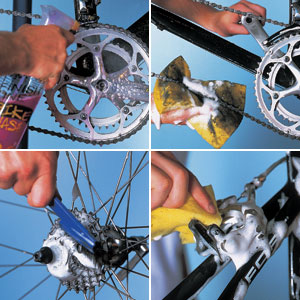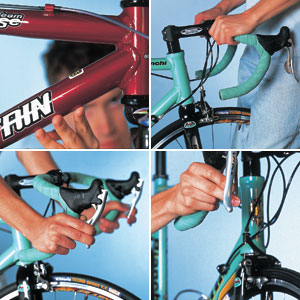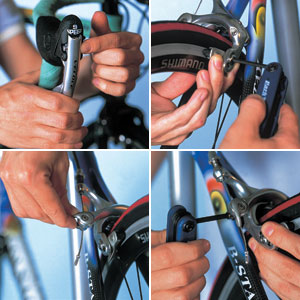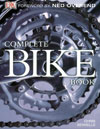How to maintain your bike
Maintaining your bike is your responsibility, both for your safety and that of the friends you ride with. Luckily, tuning up your bike isn’t as hard as it might seem when you first try.
Here’s how to maintain some of the components on your bike. Contact your local bike shop for books and advice on where to turn for more advanced maintenance tasks.
CLEANING YOUR BIKE
 Why: Oil and dirt stick to components such as brake and gear systems, making them less effective.
Why: Oil and dirt stick to components such as brake and gear systems, making them less effective.
How Often: Depends on how often and in what conditions you ride. Check your bike weekly and clean as needed.
What to Do: Spray the entire bike with a garden hose to remove excess mud and loose dirt. Use a degreaser on the crankset, derailleurs and chain to get rid of built-up oil and grit. Use hot water and a soapy sponge on the drivetrain, turning the pedals and running the chain through the sponge. Use a small cleaning brush to clean the cassette. Use a different sponge with soapy water on the rest of the bike. Use a silicon-based lubricant on the chain, derailleurs, cable ends, brake calipers and brake levers.
Tip: Start with the top of the bike and work your way down. That way dirt from above doesn’t seep into parts you’ve already cleaned.
ROUTINE SAFETY CHECKS
 Why: Reduce the chance of mechanical failure causing an accident.
Why: Reduce the chance of mechanical failure causing an accident.
How Often: Before every ride.
What to Do: Check the frame for bulges or cracks, a sign that the tube is fatigued. Check the wheels and spokes for cracks and irregularities. Scan the entire drivetrain for worn parts. Make sure every bolt and screw is tight. Try to turn the handlebar while holding the front wheel still. If it moves, tighten bolts in the steering mechanism. Check the brakes by applying both and pushing the bike forward. The bike should stop before the brakes are fully applied. If not, see “Maintaining Your Brakes.”
Tip: Don’t overtighten bolts. Applying too much force can weaken it.
MAINTAINING YOUR BRAKES
 Why: Just think about it.
Why: Just think about it.
How Often: Check your brakes before every ride. Maintain them as needed.
What to Do: Check the pads for wear. If they are glazed and hard, or if less than 1⁄8-inch remains outside the holder, replace the pads on both sides. Make sure the main brake cable is pulled taut and the anchor bolt is tightened. Turn the barrel adjuster to make sure both brakes are centered on the rim and that they just clear the rim as the wheel spins. Make sure the brake pads are directly in line with the braking surface of the rim. Loosen the bolt on the pad to adjust it. If you have to pull the brake lever all the way back before the wheels stop, loosen the cable-fixing bolt, squeeze the outside of the brake pads until they nearly touch the rim, then tighten the bolt.
Tip: Make sure your wheels are “true” while adjusting brakes. If a wheel wobbles while it spins, take it to a bike shop for adjustment.
MAINTAINING YOUR TIRES
Why: Improperly inflated tires can cause more expensive bike problems than just about anything.
How Often: Check your air pressure every time you ride.
What to Do: Use only a frame or hand pump to inflate your tires. Automobile service station pumps can blow out tires. Check tires frequently for cracks and worn treads.
Tip: Tires should be kept inflated within the range of the pressure recommended by the manufacturer. Look on the side of the tire for the recommended pressure.
 Photographs from the “Complete Bike Book,” published by DK Publishing. Reproduced with permission of the copyright holder.
Photographs from the “Complete Bike Book,” published by DK Publishing. Reproduced with permission of the copyright holder.
Want to learn more? For more information on bike maintenance, check out the “Complete Bike Book” by Chris Sidwells, available at www.scoutstuff.org or by calling 1-800-323-0736.
As a part of bicycle maintenance: How many people are required to purchase a bicycle’s license tag from their respective State’s Deparment of Motor Vehicles as a bicycle registration? Some people are required to register their bicycles with their respective states by requiring the bicycle owner to purchase a bicycle license tag similar to the license tags that are required for motorcycles, mopeds, automobiles, passenger buses, recreational sailboats and recreational motor boats, and commercial trucks.
use it for what it was made for right?
Good info. I have a very expensive bike and i need to know how to maintain it.
Thanks for the info
There’s alot of tools and liquid stuff that I don’t really have.
Check your bike for bad brakes bad berings,ect.
Why does the inner tube blow and why is it so hard to find the replacement inner tubes?
how do u fix your bikes tire with a dollar when its poped
No, hosing then drying quickly will not rust it, especially if you use oil around the easily rustable areas. (brake locks, pedals, etc.)
my aunt who races bikes said its not very good to use wd40 on you bike. but you don’t have to belive what she says if you don’t want to (but I would)
If you hose off your bike, won’t it rust?
you really do not have to talk your whole bike apart
they no how 2 do this stuff!